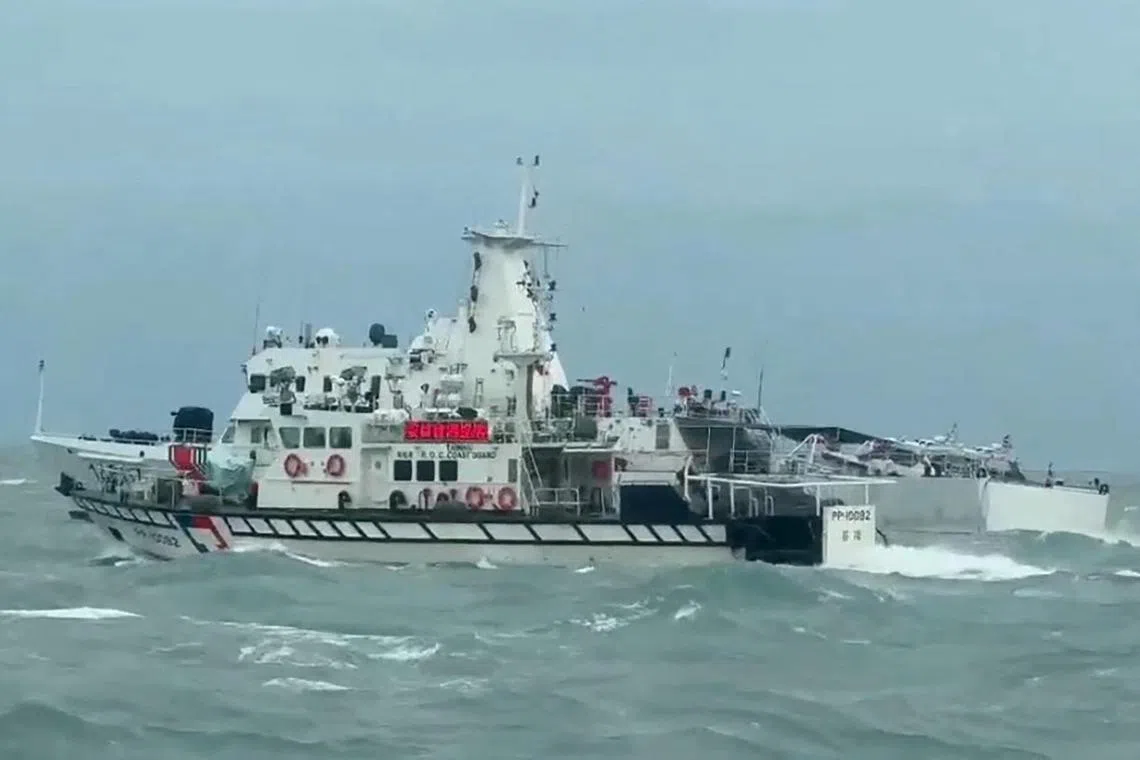China holds large-scale military drills around Taiwan
Sign up now: Get ST's newsletters delivered to your inbox

This handout photo taken and released by the Taiwan Coast Guard on April 1 shows a Taiwan Coast Guard ship (front) and a Chinese Coast Guard ship (back) sailing in waters off the Matsu Islands in Taiwan.
PHOTO: AFP
Follow topic:
TAIPEI – China on April 1 sent its army, navy, air and rocket forces to surround Taiwan in large-scale drills that Beijing said were aimed at practising for “precision strikes” and a blockade of the self-ruled island.
Taiwan dispatched its own aircraft and ships, as well as deployed land-based missile systems, in response to the large-scale exercises and accused Beijing of being the world’s “biggest troublemaker”.
The drills come after US Defence Secretary Pete Hegseth said on March 30 in Japan that the United States would ensure “credible deterrence” across the Taiwan Strait.
China opposes US support for Taiwan, which Beijing insists is part of its territory, and it has threatened to use force to bring it under its control.
Beijing has increased the deployment of fighter jets and naval vessels around Taiwan in recent years to press its claim of sovereignty, which Taipei rejects.
China deployed 21 warships around the island, including the Shandong aircraft carrier group, along with 71 aircraft and four coast guard vessels, Taiwan’s Defence Ministry said.
The number of warships was the highest since May 2024 when 27 navy vessels were reported, according to an AFP tally of the ministry’s daily figures.
Tensions across the 180km-wide Taiwan Strait have escalated since Taiwanese President Lai Ching-te took office in May 2024.
Chinese leaders loathe Mr Lai, who has been more outspoken than his predecessor Tsai Ing-wen in defending Taiwan’s sovereignty.
Mr Lai called China a “foreign hostile force”
The April 1 exercises were aimed at sending a “stern warning and forceful deterrence” to alleged separatists in Taiwan, Beijing said.
They involved “sea-air combat-readiness patrols, joint seizure of comprehensive superiority, assault on maritime and ground targets, and blockade on key areas and sea lanes”, said Senior Colonel Shi Yi, a spokesman for the Chinese military’s Eastern Theatre Command.
Beijing’s armed forces “close in on Taiwan island from multiple directions”, he said.
The drills also involved training for “multi-directional precision strikes” around the island, the Eastern Theatre Command said in a statement.
The Eastern Theatre Command – which oversees operations along the Taiwan Strait – shared a graphic with the title “Closing In”. Another graphic shared by the military depicted Mr Lai as an insect being roasted over an open fire.
A video shared by the military on X-like Weibo showed footage of weapons interspersed with animations of Sun Wukong, the legendary Monkey King from the classic Chinese novel Journey To The West.
The video climaxes with Chinese forces appearing to use satellites to mark targets across Taiwan, before ending with a flurry of rocket explosions while multiple Monkey Kings attack a giant frog monster.
China’s coast guard said it also conducted “law enforcement patrols” around the island.
“Pursuing ‘Taiwan independence’ means pushing the people of Taiwan into a dangerous situation of war,” said Ms Zhu Fenglian, a spokeswoman for Beijing’s Taiwan Affairs Office.
Taiwan’s Presidential Office condemned “China’s escalatory behaviour” and Premier Cho Jung-tai said “resorting to displays of military force is not what modern, progressive societies should pursue”.
Potential flashpoint
China has carried out multiple large-scale exercises around the island in recent years, often described as rehearsals for a blockade and seizure of the territory.
Analysts have speculated that China was more likely to attempt a blockade of Taiwan than launch an all-out invasion, which was riskier and would require a huge military deployment.
Taipei military expert Su Tzu-yun said the drills appeared to be of similar size to the “Joint Sword” exercises in May and October 2024.
Dr Lin Ying-yu of Tamkang University said holding drills straight after Mr Hegseth’s visit to the region
China wants to test the US’ bottom line ahead of a summit between President Xi Jinping and Mr Trump, said Dr Lin.
Taiwan – a powerhouse in semiconductor chip manufacturing – is a potential flashpoint for conflict between China and the US, which is the island’s most important security partner.
While the US is legally bound to provide arms to Taiwan – which Beijing opposes – Washington has long maintained “strategic ambiguity” when it comes to whether it will deploy its military to defend the island from a Chinese attack.
There have been concerns about US President Donald Trump’s willingness to protect Taiwan.
He said in March that a Chinese invasion of Taiwan would be “catastrophic”, as the island’s chipmaking titan TSMC announced a US$100 billion (S$134.3 billion) investment
The dispute between China and Taiwan dates back to 1949 when Chiang Kai-shek’s Kuomintang nationalist forces fled to Taiwan after losing the Chinese civil war with Mao Zedong’s communist fighters.
Taiwan sees itself as a sovereign country but has stopped short of declaring formal independence, which is a red line for Beijing.
Only 11 countries and the Vatican recognise Taiwan’s claim to statehood. AFP

